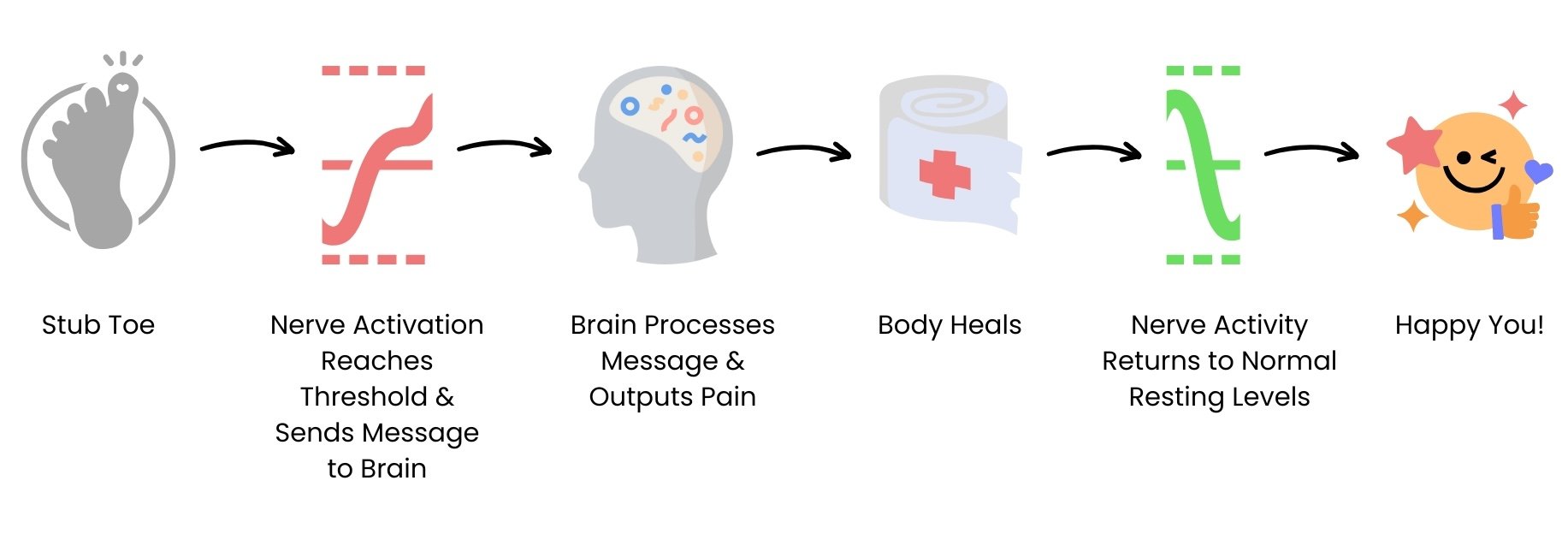Is Pain Real or in Your Head? Understanding pain, the brain, and how the nervous system affects healing
At some point you’ll experience pain and you might question, is pain real or in your head?
The short answer to that question is - no.
Pain is real and it’s not your head.
Rather, pain is an output from your brain in response to something it deems as a threat.
The good news is, pain doesn’t have to be scary and the more we understand about pain, the less of a hold it has on us.
Here’s what we’re going to talk about in this post:
How pain works
Why pain sticks around
Simple tools to decrease the sensitivity of your nerves
Who to work with for acute and chronic pain treatment
How does pain work?
Imagine this…
You get out of bed in the morning and you’re super groggy and barely awake and you stub your toe - hard - on the bed frame.
You have immediate pain (and maybe a few choice words, iykyk) and limp around for a bit.
After a few minutes, the pain has mostly gone away and you carry on with your day.
So, what’s happening with your pain in this scenario?
Let’s dive into the anatomy…
All throughout your body you have nerves that act as sensors to send signals to your brain via our nervous system.
In fact, you have 45 miles of nerves that connect your body! That’s a pretty impressive highway system, huh?
All of your nerves have a bit of “electricity” coursing through them and even at rest they’re a little bit active.
When you have an input into your system - like stubbing your toe - the activity of the nerves increases.
If that activity reaches a certain threshold the nerves send a “danger” signal to your brain.
Once that “danger” signal reaches your brain, your brain processes it to determine if there is a threat to your safety or not.
If it is a threat to your safety, your brain outputs pain and you act in accordance - you limp, move your hand off the hot stove, etc.
Can you see how pain is both real and it’s in your head?
Now, in most cases, as your injury heals the activity in your nerves decreases and returns to normal resting levels and you no longer experience pain.
Unfortunately, there are times that this decrease in nerve activity doesn’t happen and that can lead to long standing pain.
Why does pain stick around?
Sometimes when you heal from an injury, your nerves remain sensitive and continue to fire at a higher level than they were prior to injury.
In this case, it takes less input into your system for your nerves to be activated and send that danger signal to your brain.
Practically speaking, an activity that once used to feel easy like doing the dishes, going for a walk, sitting for work, now results in pain.
That’s a serious bummer and can have a huge impact on your quality life and your well-being!
Some things that can impact the sensitivity of your nerves include:
Family, household, and/or relationship demands
Fear of another injury, of continued injury, of not being able to do the things you want or need to do
Financial concerns and/or job issues
How you healed from a previous injury or how you’ve seen others heal from a similar injury
Illness, allergies, autoimmune conditions
Nutrition and/or hydration
Poor sleep, stress, travel
Etc.
Tools to Decrease the Sensitivity of Your Nerves
It’s not all bad news, I promise!
You can have a positive influence on your pain experience, decreasing the sensitivity of your nerves and nervous system, through things like:
Mindfulness practices
Deep breathing
Sleep hygiene and improving our sleep quality
Activity pacing
Graded exposure to activity
Movement practices
Many of my patients also find these phrases helpful to remember:
Motion is Lotion - movement brings more blood flow and hydration to your joints and tissues - they LOVE that!
Sore but Safe - soreness does not always equate to injury. Maybe you can remember times you’ve worked out and had soreness that felt good.
Hurt not Harm - just because there’s pain doesn’t mean there’s injury.
Key Take-aways
Pain is real, it’s complex, and your brain and nervous system play a huge role in how you experience it.
Chronic pain can result when nerves stay sensitive even after an injury has healed.
Nerve sensitivity and pain levels can be impacted by stress, fear, sleep, nutrition, and lifestyle factors.
The good news is there are simple ways to decrease nerve sensitivity and support healing, including mindfulness, deep breathing, movement, and activity pacing.
Physical Therapy and Coaching for Chronic Pain - Who to Work With
I offer holistic chronic pain treatment at Orchard Physical Therapy + Coaching in Bend, OR and pain recovery coaching online. Together, we can change your relationship to your pain and create a plan to help you re-engage in your life and activities that are meaningful for you. Contact me to find out more about working together.
References
Louw A. Pain Neuroscience Education. Presented: Therapeutic Neuroscience Education at Evidence In Motion; January 2020. Online.
Louw, A. Why do I hurt? A patient book about the neuroscience of pain. Minneapolis, MN: OPTP; 2013.
Louw, A. Pain Neuroscience Education: Teaching People About Pain 2nd ed. Minneapolis, MN: OPTP; 2018.
Disclaimer: this post is intended for informational purposes only and is not medical advice. If you are experiencing pain, it is always in your best interest to consult with your medical doctor and/or your physical therapist.




